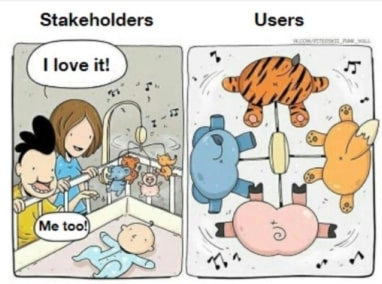

How to Manage Remote Employees to Drive Growth in Digital Agencies
- Benefits of hiring remote employees
- Drawbacks of hiring remote employees
- Hire effectively with expert assistance
- Drive remote workers performance through connection to clients’ challenges
- Work that makes sense engages and encourages to do better
- Efficient communication and collaboration in a distributed agency workforce
- Scheduling and time difference in remote employees management
In a perfect world, more projects mean more people. But we’re not there.
Hiring is challenging and time-consuming, and qualified specialists often aren’t exactly affordable. Especially if you’re the new face on the block of now-everywhere digital agencies and you need to focus on maintaining visibility.
On the other hand, talent recession is still here. The fact that happy employees equal happy customers is, too. So it’s only logical that digital agencies, as the other businesses, start moving forward the introduction of the distributed workforce. Which, among other things, means allowing employees to work from home.
The majority of Instapage’s report respondents agree that they would like to work from home at some point in their life. So there’s a demand from the potential hires. What’s in it for a digital agency?
Benefits of hiring remote employees
- Larger talent pool. Obvious, and very important in years of talent shortage.
- Fitter, happier, more productive. 77% of the employees reported an increase in productivity while working remotely compared to their in-house peers. That may have something to do with office distractions, uncomfortable environment, comfort zones, etc. All of these things have an effect on productivity. Managers confirm these numbers.
- Cost savings. Cost of in-house experts is usually higher than the cost of remote employees, sometimes even if there’s an entire team. Starting agencies sometimes don’t even have an office to invite applicants to, hence no money to keep it warm, snacks-full, and comfortable.
- High ROI of decision-making in diverse teams. Teams with people of different nationality, race, and gender make better decisions, states McKinsey’s report. Which is only logical, considering different experiences, cultures, and opinions which are trying to reach points of understanding that will fit into your clients’ wants and pains.
Drawbacks of hiring remote employees
Like almost any other initiative, establishing remote working relationships may just not work, if executed poorly.
Yeah, thanks, Cap.
Main pain points in “executed poorly” are:
- Unqualified hires. Nowadays, every second person is a marketing expert, and every third developed a site on WordPress. It’s often hard to figure out the true level of applicant’s qualification — especially if you don’t have an expertise in a given domain.
- Poor communication. Talking is important and remote workers are real members of your team. So, they need to be involved in communication with your team — especially if you want them to really help your clients. Time zones, members of the in-house team that treat remote workers like trash, no check-ups, etc. — all of that leads to stress, misunderstandings, and low productivity.
- Little or no employee engagement. We know, for instance, that developers do invisible work that often doesn’t get the recognition they deserve. Remote workers, if they’re not acknowledged, are getting into the same situation: according to HBR, quite a lot of them feel abandoned in their teams.
There are, of course, ways to fix that. Culture. Management. And while this Upwork’s report says that 63% of companies hire remote workers, less than half of these businesses have policies on how to build work process with these people. So, let’s dive into that.
Hire effectively with expert assistance
Hiring top talent is one of the main challenges for digital agencies. People make your company. To find and manage top talent in remote settings, you need infrastructure that is ready to accept them.
When your agency is young, and you have marketers, designers, and content specialists, and you're tired that the vision of clients’ brand isn’t transferred properly into their software, you want software engineers of your own. So, you start looking for them.
Who to hire? What technology that person should be expert in? Does the domain industry of a client matter? A lot of questions and the answer may lay a) in research, b) in consultations, c) in hiring a tech partner. Why is it important not to do it by yourself — or, at least, study opportunities as deep as possible.

First of all, tech is strategic. Developers do solve business challenges so they can be a valuable, killing asset in marketers’ work. Secondly, there’s no greatest turn off than bad user experience, which forces clients’ audience to leave screaming and tell their friends about it. Plus, imagine if you’re helping clients to develop a language for really complicated software; it’s a huge deal. Complicated software needs high-level development efforts. Users don’t read the user manual for your app. Don’t hope to build a high-quality software with talent who haven’t been throughout tested by an expert. Especially if it’s remote workers: their salary is usually lower than salary of in-house experts in the USA, but it’s very easy to emulate expertise. Especially if two of you are in different physical spaces and you have no idea if what the applicant’s saying is right.
Also, according to the same Upwork’s report, there’s upcoming arrival of extremely granular, specialized skills — at least, 61% of respondents believe in that. While we’re not going to generate assumptions, it’d better to have access to larger talent pool. Especially if you’re going to become a full-cycle agency. And the remote talent pool is significantly larger: 61% of hiring managers at companies that hire remote workers are more likely to think hiring becomes easier.
Drive remote workers performance through connection to clients’ challenges
Do you know what can be sad about agencies growth?
Most of Instapage’s respondents told their main challenge is searching for new clients.
We know by experience in working with agencies that most of them, at least when they’re young, are living on a profit margin and growing extensively: more clients — more money. There’s another way to increase profits, though. Intensive way of growth — and that is way more challenging.
Improve your services and… charge more. Introduce value-based pricing instead of hourly pay. Connect your profits to your clients’ profits. To do that, you need specialists who’re deeply involved in what’s going on between you and clients.
Employees — remote especially, as they’re automatically a bit disengaged from your team — need to see things from clients’ perspective and from clients’ audience’s perspective. They need to connect what they do both to your business goals, and they should know that their work is meaningful. People who think their work matters work better.
Work that makes sense engages and encourages to do better
Another important thing is the following: when we’re scrolled through comments on working in digital agencies, we’ve noticed an interesting tendency. Most of these comments — from different people living in different countries — were highlighting that pain point:
“We’re assigned with XYZ, but it doesn’t make sense to do XYZ for that client.”
You know, that situation when you agree that clients need XYZ only because of their money. You know it won’t work — won’t fit into their audience’s needs, would require much more investments than another, more simple and effective solution, etc. — but you do it anyway.

And we get that. You do it because who are you to tell people how to spend their money.
And you do it because every client is of value to you.
But the consequences aren’t shiny.
1) Clients get a low or average result and the probability of him or her referring to you as a digital visionary reduces.
2) Your employees, remote included, understand that their work doesn’t make sense, and, as we’ve already said, people actually want to deliver value. Want to make things better, to help others. Research even showed that it makes them happier. So they see they’re doing something that is useless, their abilities aren’t applied, and their engagement and motivation to do better drops.
3) You’ve got high turnover rates, unhappy clients who, maybe, want to pay for you to fix everything. And maybe not. But they don’t like you. And you probably don’t like yourself.
So, make work you do meaningful for your employees and of great value — for your client.
Efficient communication and collaboration in a distributed agency workforce
Answering the question of visibility: people who are used to work with in-house teams will need some time to adapt to the fact they not seeing their colleagues working. “I believe what I see” in terms of physical space aren’t going to work here.
Some reject the idea of employing remote workers because they would “do nothing.” Although, that’s quite a bold assumption that people actually work when they’re near you: actually, a typical employee from the USA is distracted every 11 minutes. And it takes another 25 minutes to regain focus. Developers says they are sick of distractions at the office and they harm their productivity greatly. In-house much.

Accurate KPIs and open reports will change your thoughts on employees presence. Sheets with schedule, vacations, and weekends will be used by you and your team as a source of everyone’s plans. Management software like Trello or Jira will help you to track their process. Communication tools— and policies on how to provide feedback and communicate about job-related things — are going to unite your team and help them make better work together.
1) Explicit expectations. Remember endless cycles of reviews with your clients? When a client’s requirements can be interpreted in more than one way, and you decide that you’re experienced enough to guess what he or she meant — and, at some point in time, your assumption is wrong.
The same feeling will develop in your employees if you’ll be giving them ambiguous tasks. Assign tasks to your workers as if you’d want your client to express expectations for you. Which means, among other things, clear and understandable KPI. What employees should do, where, when, and how they should report about their performance, how they will be evaluated.
And, of course, you should leave them a channel to get answers to their questions and make sure they understand that if they don’t get something, there’s nothing wrong about it.
Channels & tools to use: Introduce your workers to project management tools, like Jira, Trello, Asana, Redmine, etc. Put all documentation on Google Drive or Dropbox. Make sure they have a workflow on how and when to use all that — ask if some training is required.
2) Better feedback & better talks. More than half of employees want more feedback, and 98% feel disconnected from the working life if there’s no feedback at all. Feedback motivates, makes people feel valued and do better. In order to feedback to possess all these nice qualities, make it actionable.
Draw a clear line between vapid, empty statements and ruthful, angry criticism that is based on personal preferences and data-driven, research-based, constructive comments. Not “this is never going to work”, but, “I think, we should improve it here and there, and delete that, because…”

Involve other people in your feedback loop to avoid personal biases. Make clarity and actionability a core of your performance reviews . Feedback is vital for remote employees because sometimes it’s the only form of team communication they have. So make it good.
Channels & tools to use: Make a document on what tool to use when: when to write email, when to message on Skype or Slack (or any other messenger or platform your team decided to use). Set up meetings in Zoom, Google Hangouts, or Skype, again. Make sure to establish rules of I-statement (“I think it’s wrong” instead of “You’ve done it wrong”) and to listen to everyone. One-on-one meetings can be a valuable tool of retaining remote employees and getting feedback on teamwork, work processes, and their personal state of mind. Which is vital for employees retention and, therefore, for your business.
3) Collaboration and knowledge transfer. It’s close to previous point. As we’ve already mentioned in our article about Figma, collaboration drives performance in teams. Team that solves “business riddles” together makes better decisions — especially if it is diverse. So, make sure to provide your team, both in-house and remote parts of it, with tools to utilize the potential of working together.
Brainstorming, hands-on learning initiatives (“learn, then practice”), trainings and seminars, shared library with professional books — all these things engage and motivate your employes. For your clients, digital is a way to drive profits — but digital is changing with a terrific speed, and you have to learn and collaborate to use all it has to offer.
Also, as we said, it’s extremely important for remote workers to feel involved in your communication with clients, to connect their work with clients’ business requirements. You don’t have to introduce them, but it’d be really nice for productivity of a whole team to know their common efforts make impact on someone else’s lives.
Channels & tools to use: Figma and Google Docs — they have wonderful “Comments” feature as a place to provide feedback. Slack. Cloud-based storages.
Scheduling and time difference in remote employees management
Now, to the most challenging (in our opinion) side of a distributed workforce.
1) Boundaries. If you’re a founder of digital businesses, you’re probably familiar with an issue of work and life balance. Sometimes, there’s no work and life balance at all — that’s one of the reasons why entrepreneurs are suffering from mental illnesses more than other people.
For your remote workers — as for yourself, actually, too — it’s extremely important to build boundaries between working time and not working time. Itself, work has moved to where employees are, but where does it end? Especially if you’re working from home?
You can’t text to a person with an urgent task just because he or she is online. We mean, you can, of course, but sooner or later such attitude will turn all benefits of distributed workforce into a dust. Some will leave, and the rest of them will be stressed and their performance will drop. You don’t want that.
Boundaries are when to call and when to text “ASAP” tasks. When to take a weekend. When employees can ignore your message and don’t be punished for it. Boundaries are also in roles and responsibilities — all of them should be pointed out in contract and discussed, if any changes and additions are planning to occur.
2) Scheduling & Time Tracking. In distributed workplace, calendars and project management tools are one of your new best friends. In there, you’ll see when you can get an answer to your question — and which stage the task you assigned is currently on. Weekends, vacancies, and breaks are also there.
Also, if you’re taking hourly pay, it’d be useful to introduce a time tracking tool — although some of the management platforms already have it. Through time trackers, you’ll be able to see if someone is stuck with a task and shy to tell you about it. Also, they help you evaluate your employees’ progress.
3) Time zones. Distributed workforce often comes with a need to collaborate with people in different time zones. Virtual workplace with tools that have commenting feature are helping in the adaptation process, as well as the recurring meetings and scheduling, though it’s better to have 3-5 hours of time overlap.
For agencies, it’s extremely important to correlate forecasted “deadline” times with when people work — and when they might be needed. There’s always a way to adopt to a new schedule for few weeks if there’re boundaries and flexibility to do it.
If you read that article and felt that there are, perhaps, some opportunities you’d like to unlock through the remote workforce, drop us a line. We enjoy working with digital agencies and are happy to provide references.
Tell us about your project
Fill out the form or contact us

Tell us about your project
Thank you
Your submission is received and we will contact you soon
Follow us
